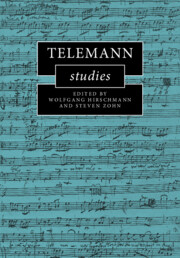Book contents
- Telemann Studies
- Cambridge Composer Studies
- Telemann Studies
- Copyright page
- Contents
- Figures
- Music Examples
- Tables
- Appendices
- Contributors
- Preface
- Abbreviations
- Part I Enlightenment Perspectives
- 1 Sehet an die Exempel der Alten
- 2 Composing “Freedom” and Freedom of the Composer
- 3 Telemann’s Beschreibung and Castel’s “Enlightenment” Harpsichord
- Part II Urban and Courtly Contexts
- Part III Nature (and) Theology in the Late Vocal Works
- Part IV Bach Family Connections
- Part V Cantata Cycles in Frankfurt, Hamburg, and Beyond
- Index of Telemann’s Works
- General Index
3 - Telemann’s Beschreibung and Castel’s “Enlightenment” Harpsichord
from Part I - Enlightenment Perspectives
Published online by Cambridge University Press: 14 July 2022
- Telemann Studies
- Cambridge Composer Studies
- Telemann Studies
- Copyright page
- Contents
- Figures
- Music Examples
- Tables
- Appendices
- Contributors
- Preface
- Abbreviations
- Part I Enlightenment Perspectives
- 1 Sehet an die Exempel der Alten
- 2 Composing “Freedom” and Freedom of the Composer
- 3 Telemann’s Beschreibung and Castel’s “Enlightenment” Harpsichord
- Part II Urban and Courtly Contexts
- Part III Nature (and) Theology in the Late Vocal Works
- Part IV Bach Family Connections
- Part V Cantata Cycles in Frankfurt, Hamburg, and Beyond
- Index of Telemann’s Works
- General Index
Summary
Telemann’s Beschreibung der Augen-Orgel oder des Augen-Clavicimbels (Hamburg, 1739) has generally been interpreted as a commentary on the “clavecin pour les yeux” invented by the French Jesuit mathematician and philosopher Louis-Bertrand Castel (1688–1757). This publication was widely received as an influential contribution to one of the liveliest debates of the Enlightenment – the intense controversy over Castel’s theories of sound-color analogy. A look into the genesis and influence of Telemann’s Beschreibung reveals the source of its text and exposes a bilingual tableau of intellectual loyalties and rivalries. Among the luminaries who weighed in were Voltaire, Rameau, Mizler, and Mattheson, whose unpublished manuscript on the subject includes the same French letter that inspired Telemann. This essay confirms that the letter’s author was Castel himself. Telemann’s text was a fairly literal translation, but it was quickly and anonymously translated back into French by Castel, who deceptively published it as though it had Telemann’s imprimatur. Due to the composer’s celebrity, this text, as erroneously attributed to him, appeared in no fewer than eight versions between the years 1739 and 1757 in French, German, and Latin.
- Type
- Chapter
- Information
- Telemann Studies , pp. 59 - 67Publisher: Cambridge University PressPrint publication year: 2022



